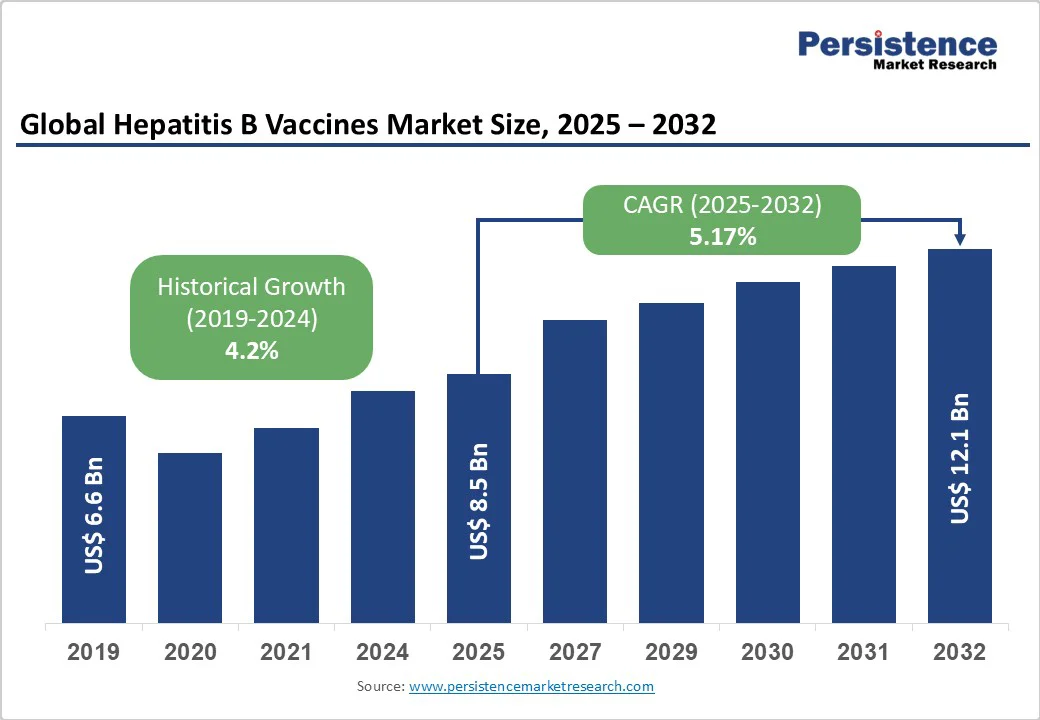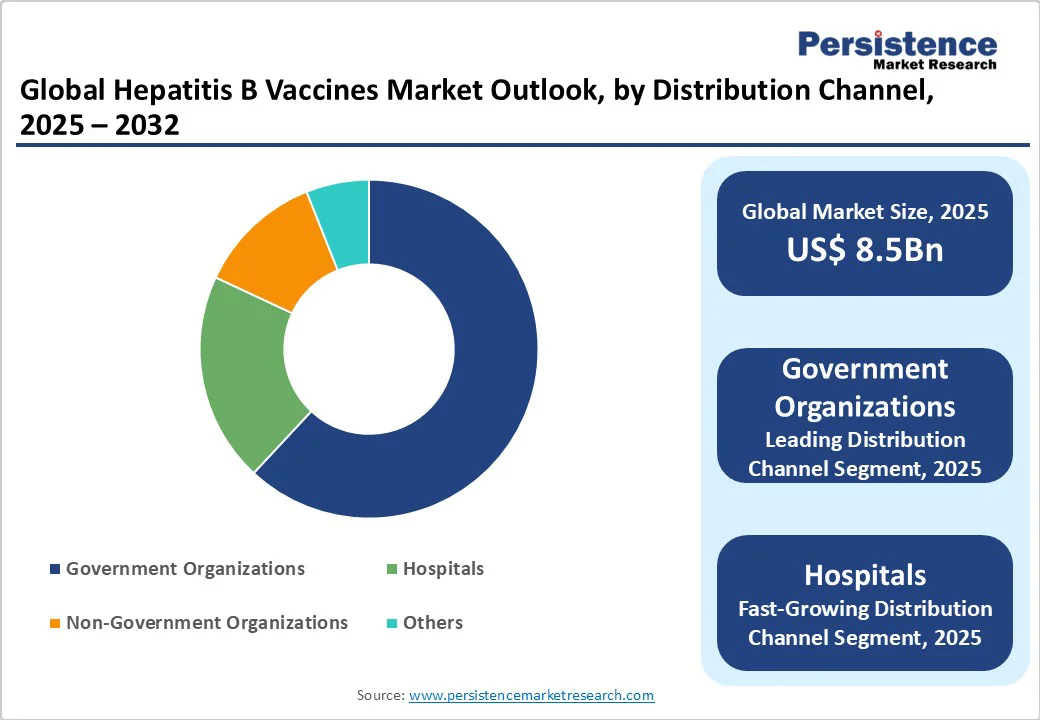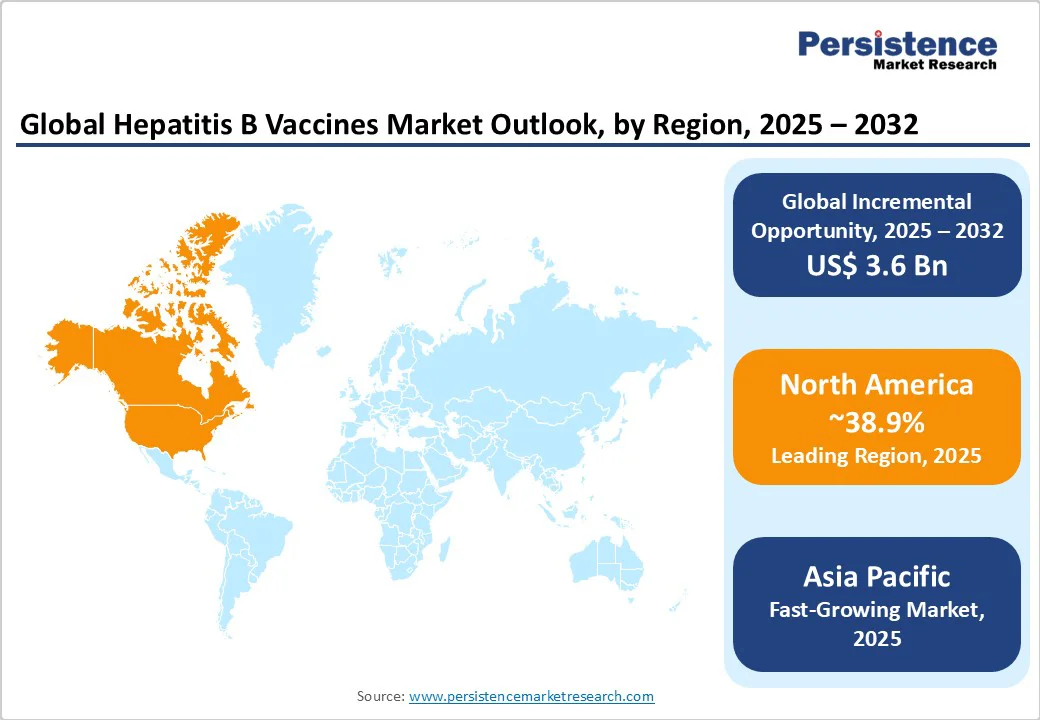ID: PMRREP3600| 177 Pages | 26 Sep 2025 | Format: PDF, Excel, PPT* | Healthcare

The global hepatitis B vaccines market size is likely to value at US$8.5 Bn in 2025 and reach US$12.1 Bn by 2032, growing a CAGR of 5.17% during the forecast period from 2025 to 2032.
The hepatitis B vaccines market is experiencing robust growth, fueled by rising demand from public health initiatives, immunization programs, and preventive healthcare sectors, where vaccine efficacy and accessibility are paramount.
| Key Insights | Details |
|---|---|
| Hepatitis B Vaccine Market Size (2025E) | US$ 8.5Bn |
| Market Value Forecast (2032F) | US$12.1Bn |
| Projected Growth (CAGR 2025 to 2032) | 5.17% |
| Historical Market Growth (CAGR 2019 to 2024) | 4.2% |

The global hepatitis B vaccines market is witnessing significant growth due to the proliferation of immunization programs and public health initiatives worldwide. Hepatitis B vaccines are critical for preventing HBV transmission, particularly among high-risk groups such as newborns, healthcare workers, and travelers.
According to the World Health Organization, by 2022, global three?dose infant hepatitis B vaccination coverage reached 85%, and there are about 1.2 million new HBV infections annually., underscoring the urgency of sustained efforts. In the Asia Pacific, China’s Expanded Program on Immunization and India’s Universal Immunization Programme vaccinate millions of infants annually, driving demand for cost-effective vaccines.
Companies such as GSK reported sales increases in hepatitis B vaccines in 2024, fueled by expanded pediatric initiatives. Government-led campaigns, rising disease awareness, and global collaborations such as Gavi, the Vaccine Alliance, ensure sustained demand, positioning immunization as a key driver for market growth through 2032.
The hepatitis B vaccines market faces challenges from the high costs of combination vaccines and persistent supply chain disruptions. Vaccine production relies on complex recombinant technologies and stringent cold chain logistics, both vulnerable to global fluctuations. In 2023, raw material shortages and geopolitical tensions increased production costs, impacting affordability in low-income regions.
Combination vaccines, while convenient, are significantly more expensive, e.g., a hexavalent vaccine such as Vaxelis costs USD 146.6 per dose compared to USD 25.6 for a single hepatitis B vaccine, limiting adoption in resource-constrained settings.
Additionally, cold chain failures in remote areas of Asia and Africa hinder distribution, with the WHO estimating a 10% vaccine wastage rate due to storage issues. These factors, combined with limited standardization in some regions, create pricing pressures for smaller manufacturers and restrict market growth in cost-sensitive markets.
The hepatitis B vaccines market is poised for significant growth, driven by increasing focus on emerging markets and innovative vaccine technologies. High-burden regions, especially in Asia and Africa, remain central to mass immunization efforts, with countries such as India and Indonesia integrating hepatitis B vaccines into their routine immunization programs.
Companies such as the Serum Institute of India are responding by developing low-cost recombinant vaccines, improving affordability and access. Innovations such as Dynavax’s Heplisav-B, which features an adjuvant for quicker immunity in adults, highlight advances aligned with sustainability and enhanced efficacy.
Additionally, government incentives-such as the European Union’s Health Union strategy and funding from the U.S. Biomedical Advanced Research and Development Authority (BARDA)-support research into thermostable and therapeutic vaccines.
These initiatives encourage manufacturers to develop eco-friendly, equitable vaccine solutions tailored to meet unmet needs in high-prevalence regions. Collectively, these factors create strong opportunities for market expansion through 2032, fostering broader global protection against hepatitis B.

The Asia Pacific region is the fastest-growing region, largely due to the high prevalence of HBV and extensive immunization efforts, particularly in China and India. China, home to over 87 million chronic hepatitis B carriers according to the WHO, has achieved remarkable success through its Expanded Programme on Immunization (EPI), reaching 99% infant vaccination coverage.
This strong public health infrastructure drives consistent vaccine demand. Similarly, India’s Universal Immunization Programme targets 27 million newborns annually, increasing the need for affordable and accessible hepatitis B vaccines.
Key manufacturers such as the Serum Institute of India and Shenzhen Kangtai Biological Products are expanding production capacities to meet both domestic demand and growing export opportunities. Additionally, rising urbanization and the establishment of pharmaceutical hubs enhance regional healthcare capabilities. WHO-supported initiatives such as the Belt and Road health corridor further strengthen collaboration and resource sharing, positioning the Asia Pacific to maintain its leadership in the hepatitis B vaccine market through 2032.
North America holds a dominant 38.9% share in 2025, propelled by strong public health initiatives and advanced healthcare infrastructure in both the U.S. and Canada. The U.S. benefits from comprehensive vaccination mandates targeting both infants and adults, with the CDC’s Advisory Committee on Immunization Practices (ACIP) recommending hepatitis B vaccination for all adults aged 19-59.
This broad recommendation helps close vaccination gaps and reduce disease incidence. In Canada, the National Advisory Committee on Immunization (NACI) promotes the use of combination vaccines in school-based programs, boosting uptake among children and adolescents.
Leading manufacturers such as Merck and Dynavax dominate the hepatitis B vaccines market with their flagship vaccines, Recombivax HB and Heplisav-B, offering innovative formulations that improve immunization outcomes. Additionally, digital vaccine tracking systems and the increasing preference for prefilled syringes enhance vaccination efficiency and coverage. Equity-focused programs addressing indigenous and underserved populations further support rapid market expansion and public health impact across the region.
Europe ranks as the second fastest-growing region in the hepatitis B vaccines market, fueled by stringent regulatory frameworks and increasing demand in travel and migrant health sectors, particularly in Germany and France.
The European healthcare market, valued at approximately €1.2 trillion in 2022, offers a strong support for both routine infant immunizations and catch-up vaccination campaigns targeting adolescents and adults. Germany’s Robert Koch Institute actively promotes the use of recombinant hepatitis B vaccines, emphasizing safety and efficacy, while France focuses on the adoption of combination vaccines to streamline immunization schedules.
Market leaders such as Sanofi and GSK align their strategies with the EU’s Beating Cancer Plan, aiming to advance sustainable vaccine production and supply. Innovations in eco-friendly vaccine formulations and adherence to rigorous quality standards help manufacturers meet the region’s stringent regulatory demands. Additionally, rising awareness and government initiatives to increase adult vaccination coverage further drive market expansion across Europe, addressing critical public health needs.

The global hepatitis B vaccines market is highly competitive, characterized by extensive product portfolios and global distribution networks. It is a fragmented market with numerous domestic and international players, from large corporations such as GSK and Merck to regional manufacturers such as Shenzhen Kangtai, focusing on localized offerings in the Asia Pacific. Companies invest in recombinant technologies and adjuvanted vaccines to enhance market share, driven by demand in immunization and therapeutic applications.
The Hepatitis B Vaccines market is projected to reach US$8.5 Bn in 2025.
Growing immunization programs and expanding applications in high-prevalence regions are the key market drivers.
The hepatitis B vaccines market is poised to witness a CAGR of 5.17% from 2025 to 2032.
Rising demand in emerging markets and advancements in next-generation vaccines are key opportunities.
GSK plc, Merck & Co., Inc., Dynavax Technologies, and Serum Institute of India are key market players.
| Report Attribute | Details |
|---|---|
| Historical Data/Actuals | 2019 - 2024 |
| Forecast Period | 2025 - 2032 |
| Market Analysis | Value: US$ Bn/Mn, Volume: As Applicable |
| Geographical Coverage |
|
| Segmental Coverage |
|
| Competitive Analysis |
|
| Report Highlights |
|
By Vaccine Type
By Packaging Type
By Distribution Channel
By Region
Delivery Timelines
For more information on this report and its delivery timelines please get in touch with our sales team.
About Author